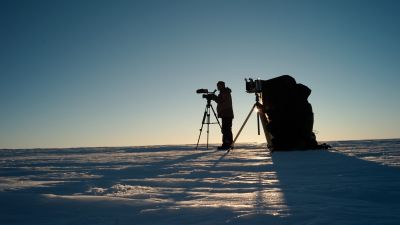
The Data Collection Collective
Various projects collect data automatically with the use of specialised equipment installed at or in the vicinity of the Princess Elisabeth Antarctica. This gallery shows a number of these instruments in action in the field!
-
Quinten Vanhellemont from the Royal Belgian Institute of Natural Sciences calibrates a HYPSTAR instrument, which analyses the light reflectance on snow and ice for the Horizon 2020 HYPERNETS project.
© International Polar Foundation
-
Olivier Francis, who has been working for many years on the University of Luxembourg's GIANT project at PEA, shows off the GNSS antenna linked to one of the GPS installed at the station's north scientific shelter
© International Polar Foundation
-
Preben Van Overmeiren (UGent) and Andy Delcloo (Royal Meteorological Institute of Belgium) installing a mini Automatic Weather Station on the roof or PEA in the framework of the BELSPO-financed CLIMB project.
© International Polar Foundation
-
The Japanese National Institute of Polar Research (NIPR) AURORA project utilises an unmanned aurora observatory (UAO-2) to detect and study aurora borealis during the Antarctic winter. Here IPF engineer Johnny Gaelens performs maintenance on its instruments.
© International Polar Foundation
-
An Automatic Weather Station installed in the field collects all kinds of meteorological data used in making regional weather forecasts and climate models.
© International Polar Foundation
-
Cimel and MaxDoas instruments from RMI's BELSPO-financed CLIMB project perched atop the roof of the Princess Elisabeth Antarctica.
© International Polar Foundation
-
A Volatile Organic Compound (VOCs) collector sits on a rocky outcrop on the Antarctic Plateau south of the Sør Rondane Mountains
© International Polar Foundation
-
The Royal Meteorological Institute’s Brewer Spectrophotometer is an instrument that provides observations of Ozone Column and Sulphur Dioxide (SO2) in the atmosphere. It also takes ultraviolet radiation measurements measurements.
© International Polar Foundation
-
ON the PEA's roof the Cielometer observes the level and amount of clouds in the sky while the Micro Rain Radar analyses the spectral drop densities and reflectivity in the atmosphere.png
© International Polar Foundation









